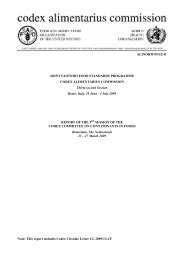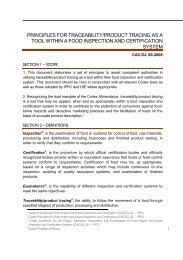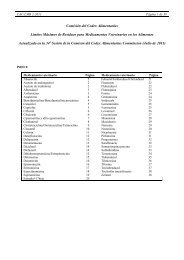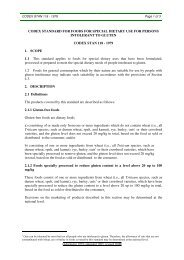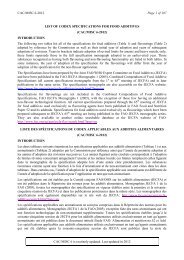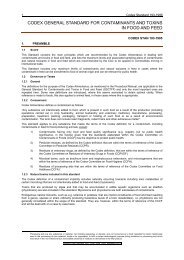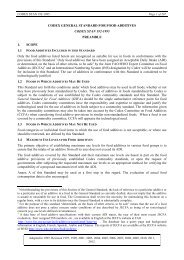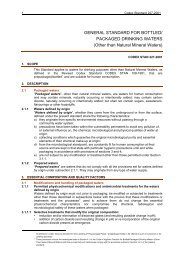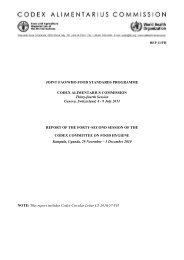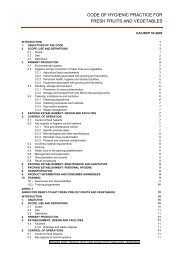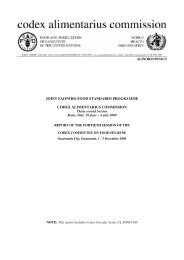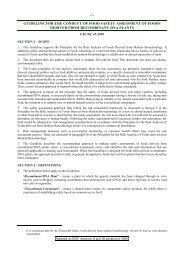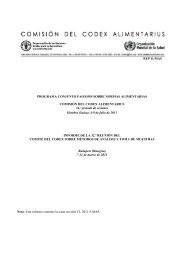proposed draft guidelines for the validation of food safety control
proposed draft guidelines for the validation of food safety control
proposed draft guidelines for the validation of food safety control
Create successful ePaper yourself
Turn your PDF publications into a flip-book with our unique Google optimized e-Paper software.
CAC/GL 69 - 2008 Page 6 <strong>of</strong> 16<br />
particularly in <strong>food</strong> processing unit operations. Quantitative demonstration and documentation <strong>of</strong><br />
appropriate log reduction <strong>of</strong> a specified pathogen by a specific microbiocidal process is an example <strong>of</strong><br />
<strong>validation</strong> <strong>of</strong> a <strong>control</strong> measure by experimental trials. If <strong>the</strong> risk from a hazard is associated with<br />
growth <strong>of</strong> <strong>the</strong> pathogen to unacceptable numbers, <strong>the</strong>n <strong>the</strong> conditions (e.g. product <strong>for</strong>mulation,<br />
processing parameters, packaging or conditions <strong>of</strong> storage and distribution) that prevent <strong>the</strong> growth <strong>of</strong><br />
<strong>the</strong> pathogen may need to be validated and documented using appropriately designed experimental<br />
trials. For example, if water activity must be <strong>control</strong>led in a product to prevent growth <strong>of</strong><br />
Staphylococcus aureus, <strong>the</strong>n <strong>validation</strong> can be achieved by demonstrating that <strong>the</strong> water activity <strong>of</strong> <strong>the</strong><br />
product under expected conditions <strong>of</strong> storage and distribution will be equal to or less than <strong>the</strong> specified<br />
water activity.<br />
Scale up <strong>of</strong> laboratory-based experimental trials in a pilot plant is helpful in ensuring that <strong>the</strong> trials<br />
properly reflect actual processing parameters and conditions. However, this almost always requires <strong>the</strong><br />
availability <strong>of</strong> appropriate non-pathogenic surrogate microorganisms, as viable pathogenic<br />
microorganisms should not be purposefully introduced into a <strong>food</strong> production facility. When surrogate<br />
microorganisms are used, <strong>validation</strong> should cover <strong>the</strong> appropriateness <strong>of</strong> <strong>the</strong> surrogates. Validation may<br />
have to be limited to a laboratory/pilot plant if <strong>the</strong>re are no appropriate surrogate microorganisms<br />
available that can be used to acquire data under actual production conditions.<br />
Additional <strong>safety</strong> margins may be required to account <strong>for</strong> <strong>the</strong> uncertainty or variability <strong>of</strong> <strong>the</strong> <strong>control</strong><br />
measure or combination <strong>of</strong> <strong>control</strong> measures in achieving <strong>the</strong> desired level <strong>of</strong> <strong>control</strong> when implemented<br />
in a full scale operation.<br />
• Collection <strong>of</strong> data during operating conditions in <strong>the</strong> whole <strong>food</strong> operation. When this approach is<br />
used, biological, chemical or physical data relating to <strong>the</strong> hazards <strong>of</strong> concern are collected <strong>for</strong> a<br />
specified period (e.g. 3-6 weeks <strong>of</strong> full scale production) during operating conditions representative <strong>of</strong><br />
<strong>the</strong> whole <strong>food</strong> operation, including periods where production is increased, e.g. holiday rush. For<br />
example, when <strong>the</strong> <strong>food</strong> <strong>safety</strong> <strong>control</strong> system is contingent upon <strong>the</strong> use <strong>of</strong> good veterinary or<br />
agricultural practices in <strong>the</strong> field or good hygienic practices in <strong>the</strong> processing establishment, it may be<br />
necessary to validate <strong>the</strong>se measures through <strong>the</strong> use <strong>of</strong> intermediate/finished product and/or<br />
environmental sampling and testing. Sampling should be based on <strong>the</strong> use <strong>of</strong> appropriate sampling<br />
techniques, sampling plans and testing methodology. Data collected should be sufficient <strong>for</strong> <strong>the</strong><br />
statistical analyses required.<br />
• Ma<strong>the</strong>matical modelling. Ma<strong>the</strong>matical modelling is a means <strong>of</strong> ma<strong>the</strong>matically integrating scientific<br />
data on how factors affecting <strong>the</strong> per<strong>for</strong>mance <strong>of</strong> a <strong>control</strong> measure or combination <strong>of</strong> <strong>control</strong> measures<br />
affect <strong>the</strong>ir ability to achieve <strong>the</strong> intended <strong>food</strong> <strong>safety</strong> outcome. Ma<strong>the</strong>matical models, such as pathogen<br />
growth models to assess <strong>the</strong> impact <strong>of</strong> changes in pH and water activity on <strong>the</strong> <strong>control</strong> <strong>of</strong> pathogen<br />
growth or <strong>the</strong> use <strong>of</strong> z-value models to determine alternative <strong>the</strong>rmal processing conditions, are used<br />
extensively by industry. This can also include <strong>the</strong> use <strong>of</strong> risk-based models that examine <strong>the</strong> impact <strong>of</strong> a<br />
<strong>control</strong> measure or combination <strong>of</strong> <strong>control</strong> measures fur<strong>the</strong>r along <strong>the</strong> <strong>food</strong> chain. Effective use <strong>of</strong><br />
ma<strong>the</strong>matical modelling typically requires that a model be appropriately validated <strong>for</strong> a specific <strong>food</strong><br />
application. This may require additional testing. Validation based on <strong>the</strong> use <strong>of</strong> ma<strong>the</strong>matical<br />
modelling should take into consideration <strong>the</strong> uncertainty/variability limits associated with <strong>the</strong> models’<br />
predictions.<br />
• Surveys. Surveys can be used to validate <strong>control</strong> measures, as appropriate, in conjunction with o<strong>the</strong>r<br />
approaches to demonstrate <strong>the</strong> expected level <strong>of</strong> <strong>control</strong> <strong>of</strong> hazards can be achieved. For example, an<br />
evaluation <strong>of</strong> consumers’ understanding <strong>of</strong> in<strong>for</strong>mation on <strong>the</strong> label prior to or during <strong>the</strong> design <strong>of</strong> a<br />
label can be considered a <strong>validation</strong> approach <strong>for</strong> labelling as a <strong>control</strong> measure. 9 Care should be taken<br />
to ensure that statistically valid surveys or o<strong>the</strong>r activity provide data that are accurate and appropriate<br />
<strong>for</strong> use by an individual <strong>food</strong> business operator or competent authority.<br />
9<br />
Note that surveys carried out after <strong>the</strong> product is in <strong>the</strong> market place to assess whe<strong>the</strong>r consumers are following <strong>the</strong><br />
instructions is a verification activity.



